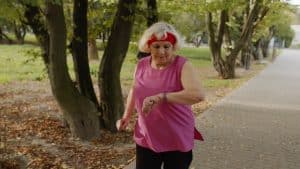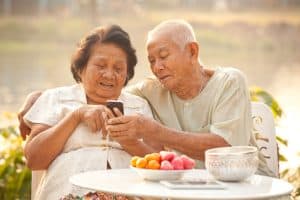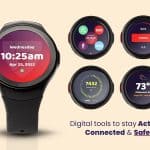
Your smartwatch might already have safety features you didn’t know about. Check those before turning to other apps, services, or devices.
No matter your age, staying healthy and safe is a priority. However, as we get older, that extra peace of mind that comes with knowing help is always nearby is even more crucial. Thankfully, technology has given older adults and their loved ones solutions to common issues ranging from emergency response to locating someone to choosing healthy habits.
We have a rundown of the best personal safety devices, apps, and alarms that you can use as you begin to research which technology might suit your situation the best. Read our Medical Guardian reviews for even more product information and pricing.
Before You Buy Anything
It’s important to research anything you want to download or add to your home. Here are a few things to consider before you purchase any type of safety device, app, or alarm:
- Make a list of what you want. While no app or technology will be perfect, if you take time to jot down your problems or concerns, you can use the top ones to help you determine what features your new purchase will need in order to be effective.
- Read reviews. Today, you can find reviews for nearly anything online. Once you have your potential purchases narrowed down, you can begin reading reviews to see what the common threads are. Remember to not give as much credit to the super low and super high scores, as those are typically outliers. Instead, read the comments from other reviews to see if there are any consistent problems you should be aware of.
- Ask around for feedback. If you are looking at a specific app or device, don’t buy one before at least asking for feedback from your friends, family, and colleagues. Chances are, someone has had some experience with what you are looking at and they can talk more about their experience. They may even be able to pull out their phone and show you the app or device in action so you can experience it before you make a decision.
- Know your budget. Don’t look at any potential purchase that is above your budget. Instead, nail down your budget first and then look at products within that limit.
- Ask for a guarantee or trial period. Using new technology can be frustrating initially, especially for seniors. It is beneficial to see if any potential products feature a money-back guarantee or a trial period so that you can return it without penalty if it does not work for your situation.
- Be prepared to not buy anything right away. The more you know about a service or app, the better and you won’t likely ask every question during your first visit to the website or store. Remind yourself to be patient and take the time to do your research instead of purchasing something too quickly.
- Compare and contrast. Chances are, you’ll find more than one company that has a device, app, or service that will meet your needs. Be sure you are taking time to compare and contrast what each company has to offer as well as costs. You can often narrow down your list to just a few options after a quick comparison.
Know the Safety Features on Your Phone Now
If you are looking to purchase an app or alarm, be sure you aren’t spending money on something you already have access to for free. Smartphones are already well-equipped with some features and apps when you purchase it; depending on your needs, you might not need to add in anything extra.
For example, iPhones are already equipped with Share My Location capabilities. If you are worried about getting lost or wanting family caregivers to know where you are in case of an emergency, you can use your Share My Location feature instead of purchasing an app or service to do the same.
Many smartphones also already have an emergency call feature, where you hold a specific button down on the phone in order to call 9-1-1. If you are an older adult who keeps their smartphone nearby at all times, you might feel comfortable using this feature for now and not investing in a personal alarm or other emergency system.
General Safety and Check-In Apps

A quick check-in app on a smartphone can give family caregivers peace of mind.
Not all smartphone users need the same services when it comes to safety or protection. However, there are some apps that cover general safety that might be good for you or your loved one. Here are a few to research to see if they might suit your situation.
Senior Safety App: Available for Androids, the Senior Safety app monitors phone location as well as emergency health information, potential falls, and even spam phone calls.
Users can link their activity to their family caregivers, giving family members insight to any unusual activity or periods of inactivity that could indicate an issue. An easy to use SOS feature also allows the user to send text alerts to family caregivers with a current location if needed.
Panic Button App: This app is available for Android users as well as iPhone users. With this app, users can push the red panic button and the app will automatically send a text message and email with your GPS coordinates to any emergency contact added in the app.
The app’s big red button is easy to see and push; it is also automatically on the user’s phone as a screensaver so that it is always available.
Snug Safety: If you need a simple system for checking in daily with your loved one, this could be the service for you. It’s free to both Android and iPhone users. Each day, the service sends a request reminding the user to check in by pushing a green checkmark in the app. Once the user checks in, they get an inspirational quote. If the user does not check in for the day, the app sends a message to emergency contacts letting them know there was not a check in for the day.
A Fitness App to Share Your Location
If you or your loved one are active, hitting the trails for a walk daily or running in new neighborhoods weekly, you can use your fitness tracker in case of emergency. For example, the Strava app is popular among runners, walkers, and cyclists for its ability to track fitness statistics as well as share with social media groups.
While the app is free for users, for an additional $5 per month, you can upgrade your services to premium. The premium version of Strava includes the Beacon feature, which will share your real-time location with anyone you choose, including your emergency contacts. It will send a message that includes your location as well as when you started your activity and how long you have been active. It even shares how much is left of your battery. You can rest assured that if you take a tumble on a hike, your emergency contacts can share your location with first responders if needed and send the help you need.
Wearable Technology Devices
You don’t always need a smartphone to take advantage of real-time GPS sharing or other emergency response features. Wearable devices, like a smartwatch or personal alert pendant, can be quite helpful in case of a fall or emergency inside your home or outside of it. Here are a few to consider:
- Medical Guardian: The Medical Guardian line of devices includes a variety of choices for all budgets and styles. You can use a pendant or a watch to send requests for assistance, as well as to call family members. Most devices are equipped with fall detection technology so that monitoring center team members can check in with any user who logs a potential fall.
- Lifeline Systems: Formerly known as Philips Lifeline, the Lifeline Systems group of products is also diverse. Their GoSafe2 on-the-go system includes a pendant the user can wear to request help. Families can also stay in the loop with the needs of their loved one with a Philip Cares caregiving management app.
- Bay Alarm Medical: The Bay Alarm Medical team offers comprehensive medical alert monitoring packages for in-home and on-the-go options. The wearable pendant is easy to use and runs off a 4G LTE cellular service
Know the Safety Features in Your Smartwatch Now
Similar to your smartphone already being equipped with features or apps that could keep you safe, your smartwatch might already be equipped with features that can assist you in monitoring your health as well as to get assistance in case of emergency.
For example, if you own an iPhone series 4 or higher, you are already able to monitor your blood pressure, oxygen saturation levels, fitness activity, and even potential falls. The watches are equipped with fall detection technology and will alert the user if movement indicates a potential fall. The user can designate that they are ok or if they need assistance and use the SOS button to call for help.
Other smartphones have safety features and Share My Location features so that in case of a fall or other crisis, the user can easily share their location to a specified contact.
If you aren’t sure what type of features your current smartwatch has, a quick internet search for your brand and model can give you an overview.
If You Stay Home
Some adults are simply at home more than they are out, and that is fine. For peace of mind, many seniors will choose to have a medical alert device that supports them at home only. These home-base systems are easy to use and often do not extend services outside of the home. For example, the iconic Life Alert system offers a home-base that works with a pendant that users wear inside the home and use to call for help in case of a fall or emergency. The Life Alert setup is relatively easy but there may be more affordable options.
Before you choose which device, app, or alarm will suit your situation in the new year, take a moment to write down what you need. Then, investigate your current technology, like your smartphone or smartwatch, to see if those already meet some of the needs on your list. Then, you can look for a service, app, or device that will meet any unmet needs. Good luck!


